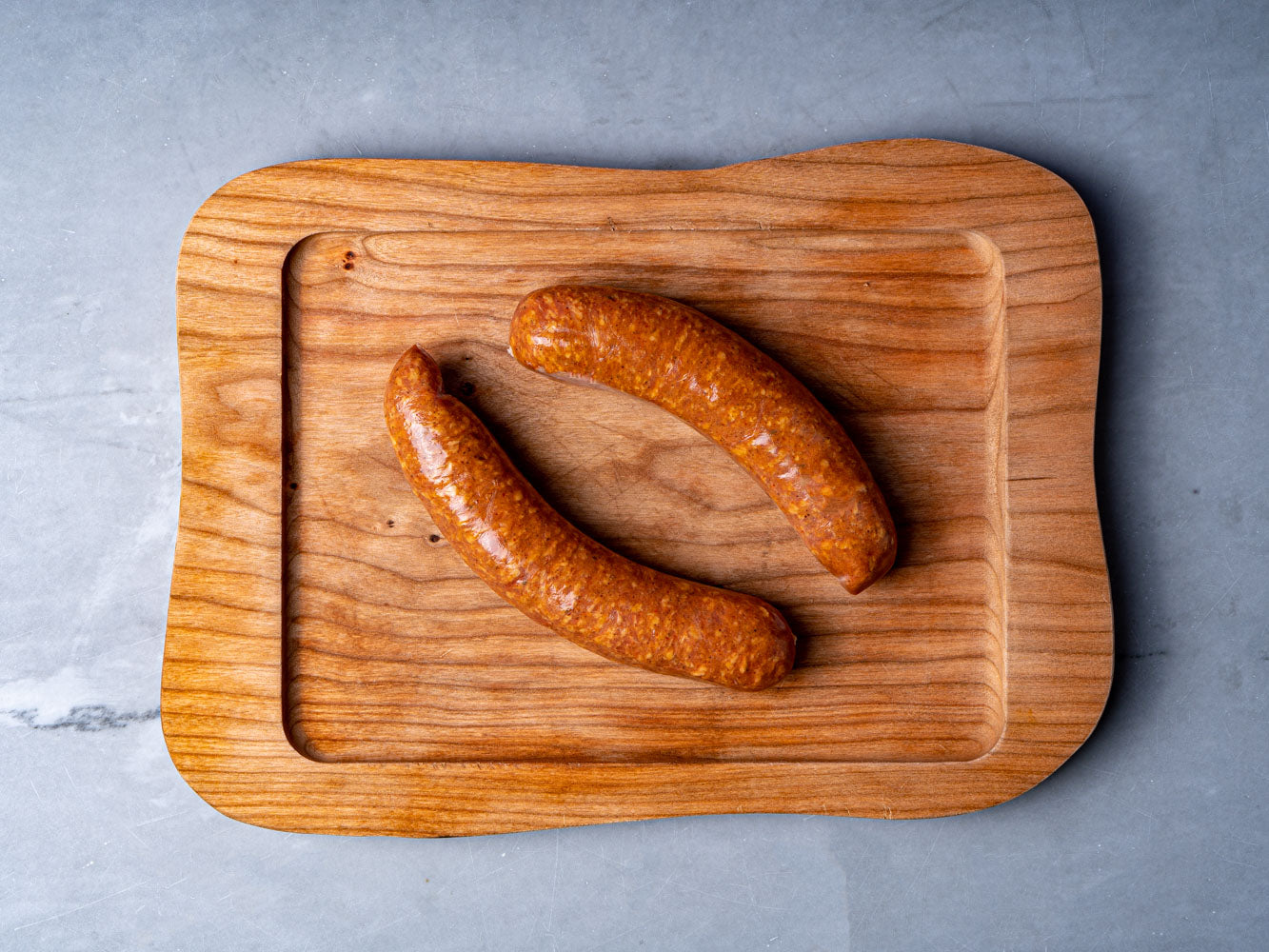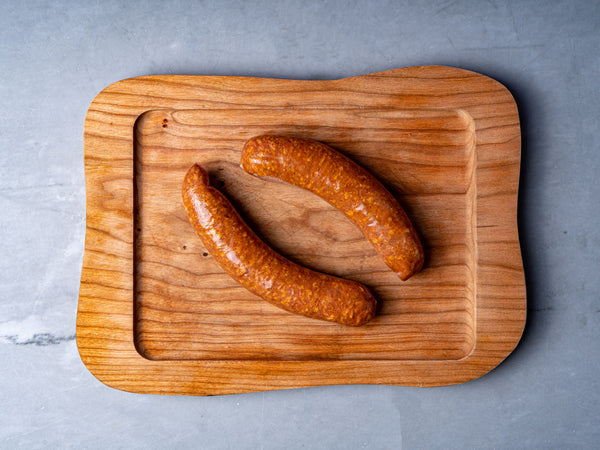



A Louisiana style sausage smoked and seasoned with garlic, onion, and spices by The Mayor in Richmond, Virginia — Three 12 oz packs, 2 links per pack
Andouille Pork Sausage
Louisiana style sausage smoked and seasoned with garlic, onion, and spices
Three 12 oz packs, 2 links per pack, fully cooked
Red Wattle or Berkshire
We sent a fresh batch of all Red Wattle pork shoulder to The Mayor, a small-batch sausage maker in Richmond, Virginia, who adapted their andouille sausage recipe for us.
Try these quintessential smoked and spicy Louisiana links, famed for being at the heart of Creole cuisine between a bun or in our new shrimp jambalaya - see the recipe here!
At Heritage, we pay respect to New Orleans by going full-throttle Red Wattle, championing the pig breed that arrived to this land in the 1800s through the Gulf by way of New Caledonia, and has long been a part of the Creole and Cajun cuisines that are widely represented in the flavors of this world-famous food city.
The Red Wattle has also come to represent the foundation of our business. We first started raising the Red Wattle 20 years ago with the help of Larry Sorrel, who drove thousands of miles to pick up all the breeding boars and sows he could find. At the time, we called the taste “racy” and “charmingly inconsistent,” as if the breed were bred to nimbly accommodate the various influences which inspire.
As with our entire array of sausages, we ship our end cuts from the best cuts of the pig directly to the maker, in this case Kyle who produces a heritage line exclusively for us and for a few of his local Richmond, Virginia markets. We first met Kyle as a chef in New York City, most recently at Michelin starred The Breslin, where he was a big supporter of Heritage Foods and a proponent of nose-to-tail whole animal butchery. Kyle moved South a few years back and is now a Richmond based chef and butcher, specializing in local, farm fresh cuisine.
The Mayor is a small batch sausage company using sustainable meats. The Mayor name is a family tradition, spanning generations and continents. Originally Kyle’s Grandmother’s maiden name, it has been kept alive and passed down in the form of a middle name for Kyle’s father, himself, and now his son.
Stay tuned for new flavors of Heritage sausage from this talented producer who has followed in the footsteps of so many great chefs and left the big city to take their talents to smaller towns, thus elevating the quality of American gastronomy coast-to-coast and everywhere in between.
Ingredients: pork, water, pork liver, and less than 2% of the following: salt, spices, dried onion, dehydrated roasted garlic, celery powder, dried vinegar.
When Heritage Foods started in 2001 we set out to sell heritage Thanksgiving turkeys. For three years our turkey project grew, but naturally mating turkey is a seasonal food and two of the three farmers we worked with to raise birds were looking for a more regular source of income if they were to continue working with us. So we committed to selling pork, which can be produced year round, as long as the breeds came from historic genetic lines, just like the turkeys. Now, 24 years later, Heritage Foods still works with those two original farms who together introduced the word “heritage pork” to hundreds of America’s best restaurants from coast-to-coast as well as thousands of homes through the Heritage Foods retail website.
Newman Farm Berkshire Pork
Myrtle, Missouri
In 2006 we got a handwritten letter from farmer Mark Newman asking us if Heritage Foods would ever consider selling his pasture raised old school Berkshire pigs. We said yes and a relationship grew that still continues today, now through his son David who has maintained the genetic line of Berkshires which can be traced back to the 17th and 18th century lines that came to these shores by way of the Berkshire region of England.
From the air, Newman Farm Berkshire Pork, in south central Missouri, in the heart of the Ozarks, looks more like a pioneer settlement or a holiday camp than any sort of pig farm. Wooden huts are scattered across green fields like bungalows, where contented Berkshire pigs live their lives, happily on-pasture.
Pigs on Newman Farm are raised 100% on-pasture. The sows raise their piglets in huts that dot the fields of the farm. The babies live inside the huts until they are old enough to jump over the 6-inch wooden board that blocks the entrance. Once they make the great leap, they have an entire field to run on and they can mingle with the other piglets from the other huts.
David Newman is both a farmer and scientist. “The farmer came first,” he laughs. His degrees are in animal science, and he holds a Ph.D in meat science and muscle biology, focused on meat quality. “As I became a scientist and got involved in education, I applied what I was learning to understand what we could do better.”
Berkshires were the favorite breed of British royalty and were first introduced to the New World in 1823. Since then, Berkshire bloodlines have remained exceptionally pure and have become a mainstay favorite of chefs and diners, legendary for their exceptionally bright pork flavor and thick, delicious fat cap. And if anyone were to question their excellence, just ask David. “It’s not a matter of opinion!” he insists, passionately. “It’s a scientific fact, Berkshires are the most marbled hog on the market today.” David is a master breeder and works hard to keep the lines on his farm separate and he is always working to improve the Berkshire breed on his farm.
David lives on the farm with his wife, Kristin, his mom Rita, and his two kids. “I got my start through my family. My parents were hog farmers, but primarily in the commercial pig business. In the 1980s my parents raised pigs in confinement. There were some very challenging economic times for everyone in production, and we realized we were going to have to do something differently. Kristin came from a family farming background also and is a major part of the operations success today, working for the farm along with their team of employees.
“In the 1990s my parents decided they wanted to go back to their roots. We were going to have to be very large to be successful in the commercial sector, and my father decided we should focus on quality. We changed our genetic program and our nutrition program. We became Certified Humane®, and we chose to focus on Berkshire pigs for their quality.”
David and his family are the future of American farming! They are young, energetic and very passionate about the future of agriculture. David and Kristin work with a team of farmers who raise their Berkshires to supply Heritage Foods and the national network of chefs who rely on his product for their menus.
Lazy Red Wattle Ranch
La Plata, Missouri
We met Larry and Madonna Sorell in 2002, as growers for Frank Reese and the Heritage Turkey Project. As their turkey flock grew in size, so did the Sorell’s importance to Heritage Foods.
When you see Red Wattle pork on a menu, what you are seeing is a five-state, twelve farm network founded by Larry and Madonna, dedicated to raising a storied breed that was once upon a time nearly extinct. Larry and Madonna are the heroes of this story, avatars of the heritage food movement, true believers who were destined to become the Guardians of the Red Wattle. They are proof positive of the ethos that when it comes to endangered livestock, “you have to eat them to save them.”
In the beginning, back in 2004 when the Heritage Foods wholesale business began selling pigs, a market for the Red Wattle pig was built on a handshake agreement with chefs Zach Allen and Mark Ladner, then at Lupa Restaurant in NYC. They recognized the high-quality and undiminished taste that came from a Red Wattle pig humanely raised on-pasture and antibiotic free, using traditional farming methods. The deal with Ladner, and the partnership with Larry and his Lazy Red Wattle Ranch, were part of the origins of Heritage Foods.
“We traveled 18,000 miles to get started,” Larry says matter-of-factly about a Heritage Foods Odyssey whose mission was to search out rare Red Wattle sows and collect a viable genetic lineage of this incredible pig whose American legacy goes back to 18th century New Orleans. "When we began, we had two Red Wattle gilts and a boar, and we had to travel all over the United States to start a herd."
“Now I’ve kinda retired from raising animals, but we have a dozen Amish growers working with us, and I pick up the hogs and pay for them, and then bring them to the processor, Paradise Locker. I drive a tractor trailer and go around picking up three hundred pounders, fifty to eighty head a week. We have farms in Illinois, Kansas, Nebraska, Missouri, Iowa... that’s a lot of traveling. We may have four or five pick-ups every week. You wear out a truck pretty fast.”
Larry, now over eighty, does less of the driving, but he still keeps all the relationships going, which isn’t easy considering the Amish don’t have phones inside their homes! “I’ll have to quit sometime but right now it’s going pretty good. The driving is easy. The hard job is you gotta keep Amish families happy, picking up their hogs, coordinating, monitoring the size of the animals, and making sure we have the right amount — each week we round up 50 to 100 pigs. And we’ve been doing it for almost 20 years now.”
Thanks to Larry and Madonna’s work, the Red Wattle was upgraded to Threatened status from Critical on The Livestock Conservancy’s watch list, a great achievement for the cause of biodiversity, one of the most important issues of our time.
Red Wattle
Threatened: Fewer than 1,000 annual registrations in the United States.
Origin: 18th Century Louisiana by way of New Caledonia.
Flavor Profile: Described as a cross between pork and beef, Red Wattle is floral and robust, concentrated and bold.
Producers: A consortium of 18 Amish families in Iowa, Nebraska, Missouri, and Kansas.
History: French colonists brought these hogs to New Orleans as a favored meat breed. The Red Wattle eventually would populate the forests of Texas where they were rounded up and brought to the great slaughterhouses of Chicago. Recognized by their signature wattles that hang from the jowl, the Red Wattle resembles Kunekune pigs of New Zealand.
Berkshire
Origin: 1823 Kentucky/ Illinois by way of Western England and outside London.
Flavor Profile: Sweet with depth of flavor, Berkshire pork is balanced and the most universally loved of all the Heritage breeds.
Producers: David Newman and a consortium of 12 family farms in Kansas, Missouri and Iowa.
History: For years the Royal Family kept a large Berkshire herd at Windsor Castle — our Berkshire pigs are traceable back to these old English genetics. This would eventually become the most popular Heritage breed of pig in the United States because of its supreme marbling. Prized by the Japanese who imported it as "Kurobuta" pork, the Berkshire is recognized by 6 white spots at the tip of its feet, nose and tail.
This is a fully cooked product. To heat, see below guidelines.
Grilling: Remove sausage from its packaging and pat it dry. Fire up your grill and lower to medium heat. Use a knife to score the sausages so they do not burst on the grill. Place the sausages on the grill and cook for 8-10 minutes, turning occasionally to ensure even cooking.
Oven Roasting: Preheat the oven to 375ºF. Remove sausage from its packaging and pat it dry. Place it on a rack in a roasting pan and place the pan in the oven. Roast for 15-20 minutes and flip sausages halfway through cooking to ensure even browning on both sides.
© 2025, Heritage Foods Powered by Shopify
